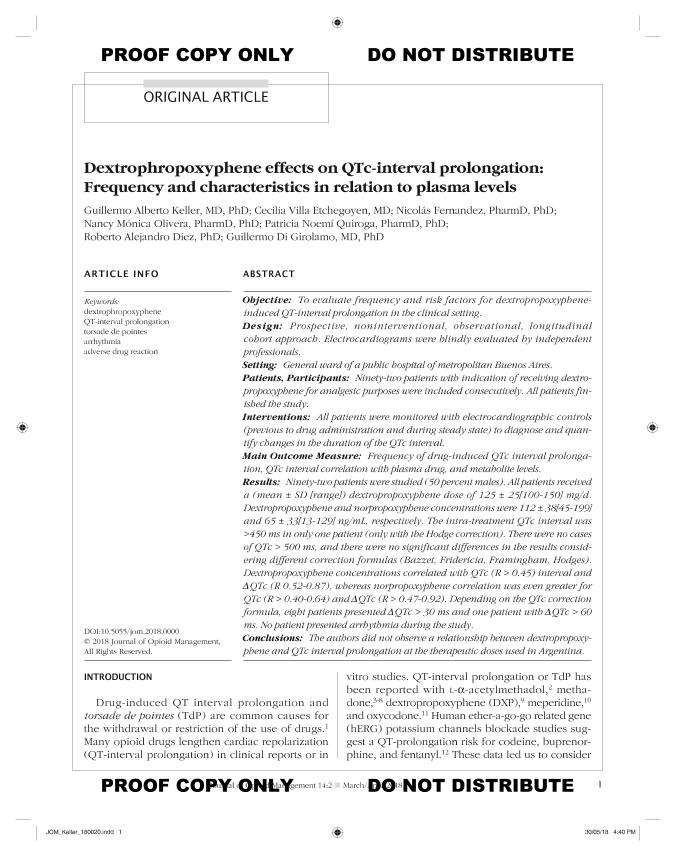Artículo
Dextrophropoxyphene effects on QTc-interval prolongation: Frequency and characteristics in relation to plasma levels
Keller, Guillermo Alberto; Villa Etchegoyen, Cecilia; Fernandez, Nicolas; Olivera, Nancy Monica; Quiroga, Patricia Noemí; Diez, Roberto Alejandro; Di Girolamo, Guillermo

Fecha de publicación:
09/2018
Editorial:
Weston Medical Publishing
Revista:
Journal of Opioid Management
ISSN:
1551-7489
e-ISSN:
2375-0146
Idioma:
Inglés
Tipo de recurso:
Artículo publicado
Clasificación temática:
Resumen
Objective: To evaluate frequency and risk factors for dextropropoxypheneinduced QT-interval prolongation in the clinical setting. Design: Prospective, noninterventional, observational, longitudinal cohort approach. Electrocardiograms were blindly evaluated by independent professionals. Setting: General ward of a public hospital of metropolitan Buenos Aires. Patients, Participants: Ninety-two patients with indication of receiving dextropropoxyphene for analgesic purposes were included consecutively. All patients finished the study. Interventions: All patients were monitored with electrocardiographic controls (previous to drug administration and during steady state) to diagnose and quantify changes in the duration of the QTc interval. Main Outcome Measure: Frequency of drug-induced QTc interval prolongation, QTc interval correlation with plasma drug, and metabolite levels. Results: Ninety-two patients were studied (50 percent males). All patients received a (mean ± SD [range]) dextropropoxyphene dose of 125 ± 25[100-150] mg/d. Dextropropoxyphene and norpropoxyphene concentrations were 112 ± 38[45-199] and 65 ± 33[13-129] ng/mL, respectively. The intra-treatment QTc interval was >450 ms in only one patient (only with the Hodge correction). There were no cases of QTc > 500 ms, and there were no significant differences in the results considering different correction formulas (Bazzet, Fridericia, Framingham, Hodges). Dextropropoxyphene concentrations correlated with QTc (R > 0.45) interval and ΔQTc (R 0.52-0.87), whereas norpropoxyphene correlation was even greater for QTc (R > 0.40-0.64) and ΔQTc (R > 0.47-0.92). Depending on the QTc correction formula, eight patients presented ΔQTc > 30 ms and one patient with ΔQTc > 60 ms. No patient presented arrhythmia during the study. Conclusions: The authors did not observe a relationship between dextropropoxyphene and QTc interval prolongation at the therapeutic doses used in Argentina.
Archivos asociados
Licencia
Identificadores
Colecciones
Articulos(SEDE CENTRAL)
Articulos de SEDE CENTRAL
Articulos de SEDE CENTRAL
Citación
Keller, Guillermo Alberto; Villa Etchegoyen, Cecilia; Fernandez, Nicolas; Olivera, Nancy Monica; Quiroga, Patricia Noemí; et al.; Dextrophropoxyphene effects on QTc-interval prolongation: Frequency and characteristics in relation to plasma levels; Weston Medical Publishing; Journal of Opioid Management; 14; 5; 9-2018; 335-344
Compartir
Altmétricas



